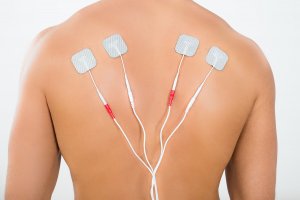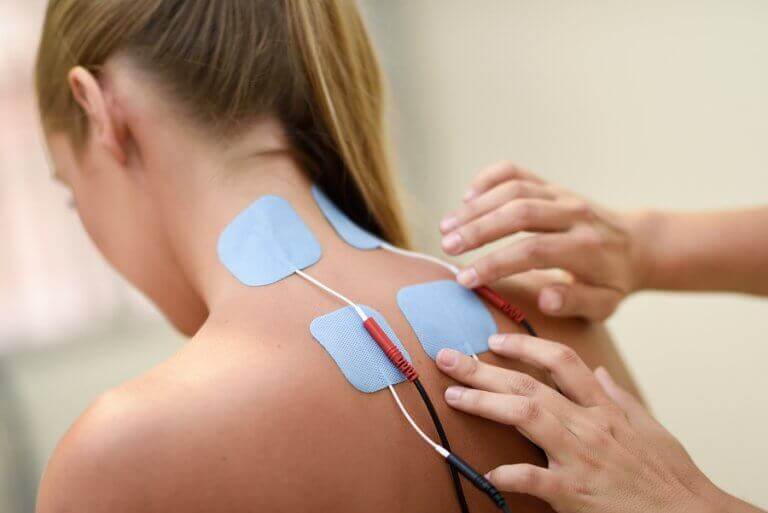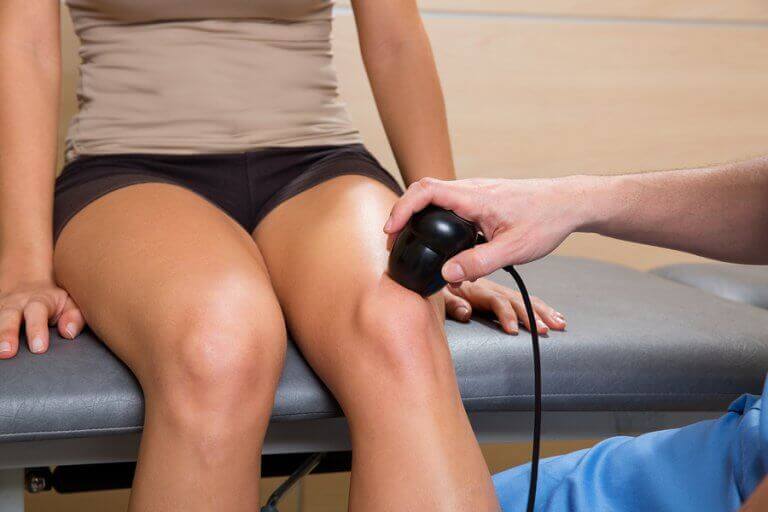Electrotherapy Benefits and Why we use It

Electrotherapy benefits are numerous and we shouldn’t be hesitant to use it. One reason is that the contraindications are only for very specific cases.
Professionals use electrotherapy for many illnesses in the area of physical therapy. Electric waves are sent throughout the body. This means that controlled electric impulses on the skin can affect the underlying structures. So the frequency and intensity of the impulses determine the physiological or other outcomes.
How do we obtain electrotherapy benefits?
Depending on the specific method that professionals chose, electrotherapy can be applied in two distinct ways. Both methods utilize a machine that emits impulses but with different ways of applying them on the body.
The first option includes electrodes, which adhere to the patient’s skin. A cinch or belt attaches other electrodes to the treated areas.
The second method uses clamps. These connect to the machines and allow the therapist to manually apply the impulses over the specific zone. These clamps also make it possible for the therapist to move the applications around a larger area.
The wide spectrum of uses for electrotherapy
There are many options for treatment when it comes to electrotherapy. The following are the most common:
Electrode application
- Muscular electrode stimulation: This is the strengthening of the musculature with the help of electric impulses. In this case, they use the electric impulses to provoke muscle contractions. One of the most common uses of electrostimulation is with sports injuries. The muscle contracts voluntarily at the time the electric impulse is applied, which allows for maximum muscle contraction. In the second place, it’s also useful to help people with problems of the nerves, in which the impulse doesn’t reach the muscle.

- TENS or transcutaneous nerve stimulation (see above photo) is the application of low-frequency impulses with the purpose of relieving pain. The patient will only feel slight tickles during the treatment that’s carried out in periods of several consecutive minutes. Then, the patient will notice an immediate improvement in the pain.
Applications with a device and electrotherapy benefits
- Ultrasound: These are well-known treatments, especially for athletes. Therapists use a hand-held device that uses a frequency causing an anti-inflammatory effect. This extends to the soft tissues that are near the bone. As a result, it could reach the tendons, the ligaments or the joints. Therefore, its use is especially important in cases of tendonitis, bursitis or sprains.

- Microwaves or diathermy: in this method, electric impulses generate heat which is sent throughout the body. Therefore, this method is considered thermotherapy since its function is to heat the tissues. While doing this, it increases the distribution of the blood and contributes to relaxing the area when there’s a chronic illness. In fact, since the electric impulses make for higher penetration, this method is better than other heat applications.
For example, it’s better than infrared rays, which makes it difficult to affect structure under the dermis. - Iontophoresis: this technique is lesser-known and consists of using a topical treatment with medicine. In fact, the fingers can apply the medicine over the affected area of the skin before using the device. The therapist moves it in gentle circular movements while it emits the electric impulses.
Contraindications
When using electric impulses to treat deep tissues of the body, there are certain precautions that you need to take. This is particularly true in some cases, and may even be dangerous in others and should not be utilized.
These include pregnant women, people with pacemakers, people with infections, or those with cancer. Also, common sense is necessary. Therefore, don’t apply electric impulses over the eyes, the heart or in the carotid artery of the neck. Because these are very delicate areas of the body, it’s better to use other methods that are safer for these areas.
In conclusion, it’s necessary to use caution with people who have metal implants. In these cases, it’s preferable to use more superficial techniques of thermotherapy.
Electrotherapy benefits are numerous and we shouldn’t be hesitant to use it. One reason is that the contraindications are only for very specific cases.
Professionals use electrotherapy for many illnesses in the area of physical therapy. Electric waves are sent throughout the body. This means that controlled electric impulses on the skin can affect the underlying structures. So the frequency and intensity of the impulses determine the physiological or other outcomes.
How do we obtain electrotherapy benefits?
Depending on the specific method that professionals chose, electrotherapy can be applied in two distinct ways. Both methods utilize a machine that emits impulses but with different ways of applying them on the body.
The first option includes electrodes, which adhere to the patient’s skin. A cinch or belt attaches other electrodes to the treated areas.
The second method uses clamps. These connect to the machines and allow the therapist to manually apply the impulses over the specific zone. These clamps also make it possible for the therapist to move the applications around a larger area.
The wide spectrum of uses for electrotherapy
There are many options for treatment when it comes to electrotherapy. The following are the most common:
Electrode application
- Muscular electrode stimulation: This is the strengthening of the musculature with the help of electric impulses. In this case, they use the electric impulses to provoke muscle contractions. One of the most common uses of electrostimulation is with sports injuries. The muscle contracts voluntarily at the time the electric impulse is applied, which allows for maximum muscle contraction. In the second place, it’s also useful to help people with problems of the nerves, in which the impulse doesn’t reach the muscle.

- TENS or transcutaneous nerve stimulation (see above photo) is the application of low-frequency impulses with the purpose of relieving pain. The patient will only feel slight tickles during the treatment that’s carried out in periods of several consecutive minutes. Then, the patient will notice an immediate improvement in the pain.
Applications with a device and electrotherapy benefits
- Ultrasound: These are well-known treatments, especially for athletes. Therapists use a hand-held device that uses a frequency causing an anti-inflammatory effect. This extends to the soft tissues that are near the bone. As a result, it could reach the tendons, the ligaments or the joints. Therefore, its use is especially important in cases of tendonitis, bursitis or sprains.

- Microwaves or diathermy: in this method, electric impulses generate heat which is sent throughout the body. Therefore, this method is considered thermotherapy since its function is to heat the tissues. While doing this, it increases the distribution of the blood and contributes to relaxing the area when there’s a chronic illness. In fact, since the electric impulses make for higher penetration, this method is better than other heat applications.
For example, it’s better than infrared rays, which makes it difficult to affect structure under the dermis. - Iontophoresis: this technique is lesser-known and consists of using a topical treatment with medicine. In fact, the fingers can apply the medicine over the affected area of the skin before using the device. The therapist moves it in gentle circular movements while it emits the electric impulses.
Contraindications
When using electric impulses to treat deep tissues of the body, there are certain precautions that you need to take. This is particularly true in some cases, and may even be dangerous in others and should not be utilized.
These include pregnant women, people with pacemakers, people with infections, or those with cancer. Also, common sense is necessary. Therefore, don’t apply electric impulses over the eyes, the heart or in the carotid artery of the neck. Because these are very delicate areas of the body, it’s better to use other methods that are safer for these areas.
In conclusion, it’s necessary to use caution with people who have metal implants. In these cases, it’s preferable to use more superficial techniques of thermotherapy.
All cited sources were thoroughly reviewed by our team to ensure their quality, reliability, currency, and validity. The bibliography of this article was considered reliable and of academic or scientific accuracy.
- Águila Tejeda Gerardo, Suárez Monzón Horacio, Delgado Figueredo Rolando, Suárez Collado Pedro O. Proceso rehabilitador de artrogriposis múltiple congénita. Rev Cubana Ortop Traumatol [Internet]. 2013 Jun [citado 2019 Oct 22] ; 27( 1 ): 91-98.
- Martínez Torres Jacqueline C, Rodríguez Adams Elsa Mª, Díaz Acosta Dayuli, Ros Montenegro Adianez, Abreu Pérez Yahima, García Delgado José Angel et al. Evaluación del efecto de la magnetoterapia, la electrotrapia y los ejercicios del suelo pélvico como tratamiento rehabilitador en la incontinencia urinaria. Rev haban cienc méd [Internet]. 2009 Mar [citado 2019 Oct 22] ; 8( 1 ).
- Bassols A., Bosch F., Campillo M., Baños J.E.. El dolor de espalda en la población catalana: Prevalencia, características y conducta terapéutica. Gac Sanit [Internet]. 2003 Abr [citado 2019 Oct 22] ; 17( 2 ): 97-107
This text is provided for informational purposes only and does not replace consultation with a professional. If in doubt, consult your specialist.








